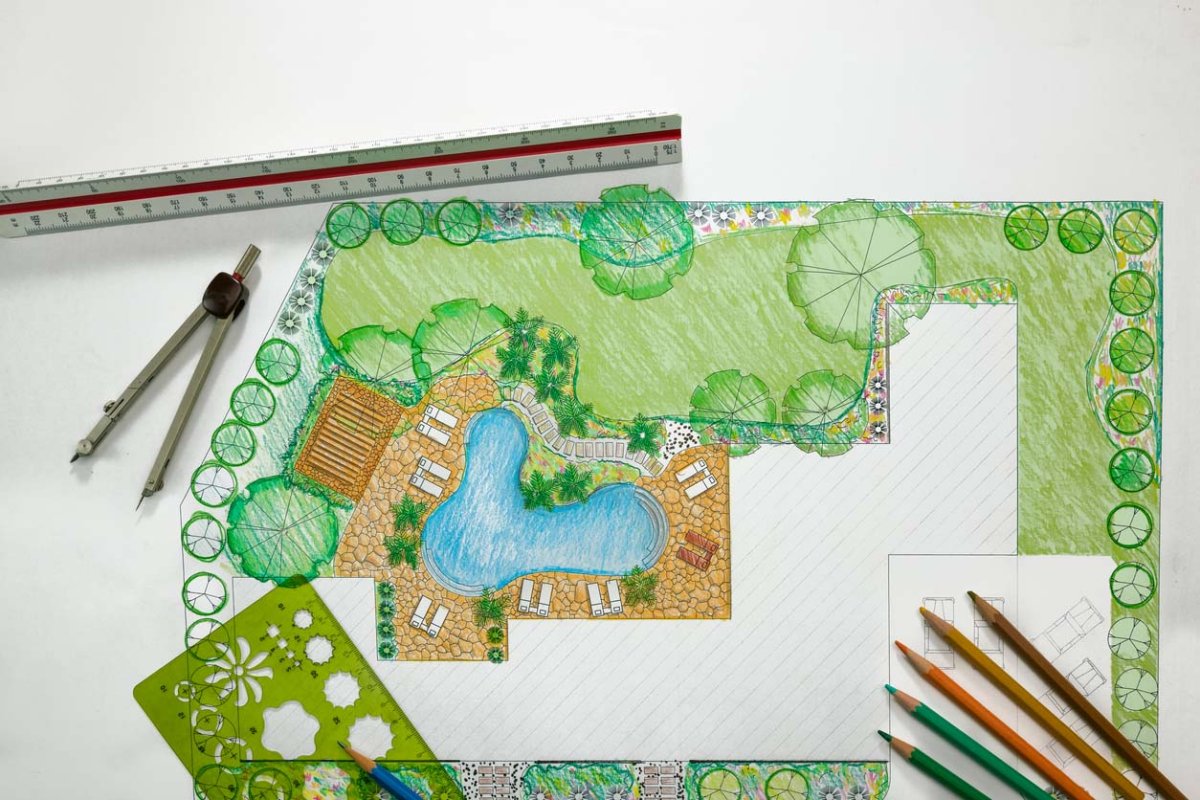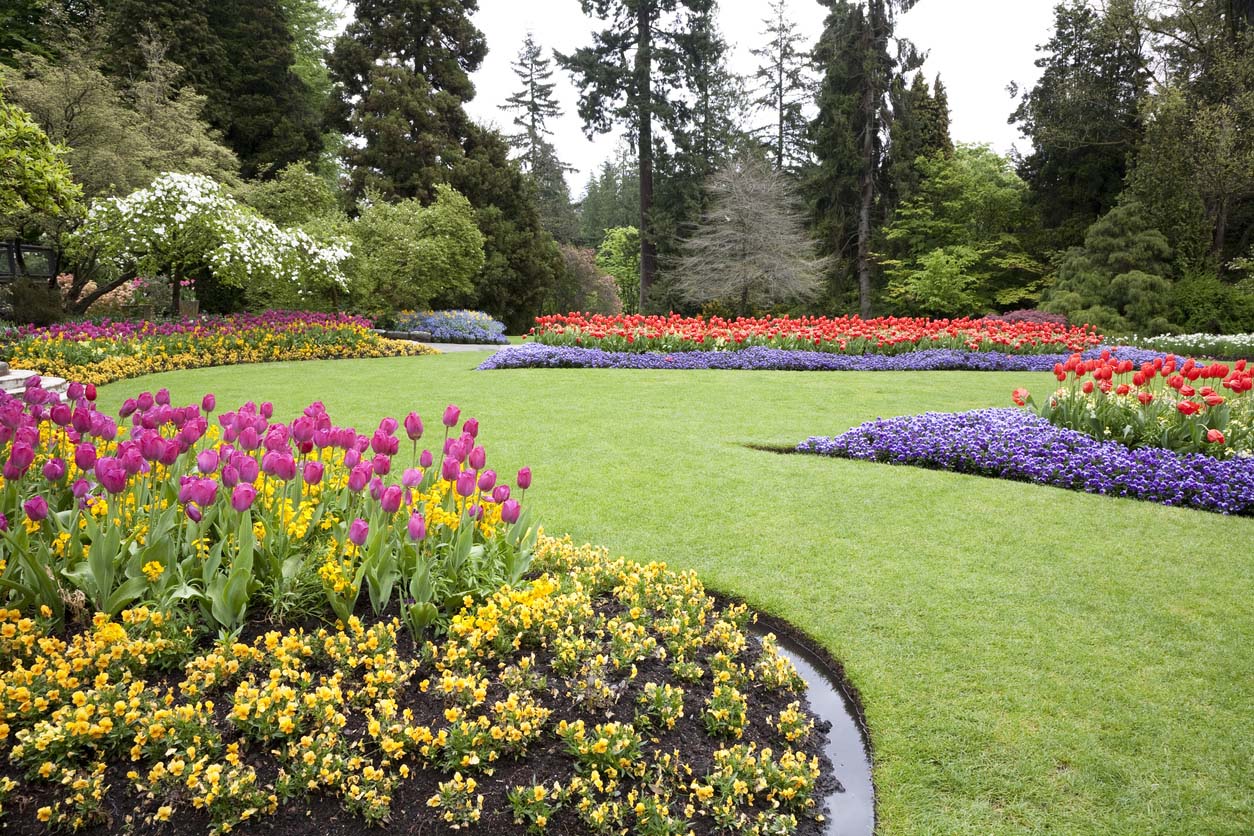
We may earn revenue from the products available on this page and participate in affiliate programs. Learn More ›
For those who love working with plants but want to take their skills to the next level, an online landscape design course may be just what they need. Landscape design schools online allow students to work at their own pace and on their own schedules, which means they won’t need to make any major sacrifices regarding current jobs or family commitments. Many of the best online landscape design courses are more affordable than formal colleges or schools but still teach the necessary skills for students to become creative and successful landscape designers. We’ve weeded through the top landscape design classes and what to consider when choosing one.
- BEST OVERALL: NYIAD Landscape Design Course Online
- RUNNER-UP: Penn Foster Landscaping Technology Career Diploma
- BEST BANG FOR THE BUCK: OSU Sustainable Landscape Design
- BEST FOR BEGINNERS: Udemy Fundamentals of Garden Design
- BEST ADVANCED PROGRAM: UCLA Extension Landscape Architecture

What to Consider When Choosing One of the Best Online Landscape Design Courses
There are several factors to keep in mind to find the best online landscape design courses. These include the length and structure of the class, class curriculum, what kind of accreditation or certificate students earn, and cost.
Landscape Designer vs. Landscape Architect
Although some landscape architects are also landscape designers, there are a few key differences between the two jobs. Becoming a landscape architect requires a bachelor’s or master’s degree in landscape architecture from an accredited university. Although many landscape designers have an associate’s degree in the horticultural field, becoming a landscape designer does not require a degree or certification. Many landscape designers have learned through work experience.
Both landscape architects and designers meet with clients to work out a landscaping project’s scope, including design requests or any challenges in the landscape. Both also create designs for clients using some of the best landscape design software. Landscape architects use CADD (computer-aided design and drafting) programs to develop their plans, so mastering this software is part of their education. The use of CADD is not necessary to become a landscape designer. For larger projects, landscape designers and architects frequently make 3D models of the work to provide clients with a more in-depth understanding of the design vision.
Landscape architects work on larger or more complex projects, including public projects such as parks, campuses, or large resorts. Landscape architects must review the jobsite and obtain construction and other required permits. Landscape designers usually work on residential and smaller jobs. Landscape designers focus on details, such as specific plants, irrigation requirements, hardscaping, or other features.
Course Length, Structure, and Curriculum
Before enrolling in any online landscape design course, prospective students will want to ensure they find a course that suits their lifestyle. It’s essential to look at how long the course will take to complete, whether it is self-paced or instructor-led, and what specific topics the classes cover.
Certifications Earned
Landscape design programs online can offer a variety of certifications, from certificates of completion to diplomas and post-baccalaureate certificates. When researching which landscape design classes to take, students will want to know what credentials they will earn by completing the course. Certifications can be beneficial (and sometimes necessary) when applying for jobs in the future.
Price
With various classes, from free online landscape design courses to post-baccalaureate programs that can take years, the prices for online landscape design classes can vary significantly. Generally speaking, courses with higher levels of certification cost more. Many of the longer certificate programs will offer monthly payment plans. Most advanced or post-baccalaureate courses will also require a deposit and material fees in addition to the tuition. When determining which online landscaping classes are best, students will want to consider their long-term career goals and if they will be able to offset the program’s cost in the future.
Program Accreditation
Before a prospective student enrolls in any online landscape design course, researching the program’s accreditation can help decide which course is best. While accreditation is not a requirement for most landscape design classes, this designation will be more critical for landscape design courses that are significant investments. Courses that offer post-baccalaureate certification or degrees should be accredited by an appropriate body recognized by the U.S. Department of Education.
Our Top Picks
When looking for garden design online courses, prospective students will want to make sure the course matches their skill set, interests, schedule, and career goals. Check out our top picks for students who want to learn landscape design online.
Best Overall
NYIAD Landscape Design Course Online
Pros
- Emphasis on business skills to prepare students for real-world work experiences
- In-depth horticultural classes taught by professional landscapers
- One-on-one feedback and access to team of advisers
- Students granted up to 18 months to finish the course
- 25 percent discount if students enroll in multiple NYIAD courses
Cons
- Reported delayed instructor responsiveness
- Course length: 8 to 12 months
- Certification earned: Certificate of completion
- Price: $999 to $1,299
- Program accreditation: New York State Education Department
Why It Made the Cut: The New York Institute of Art & Design (NYIAD) Landscape Design Course Online teaches students in-depth horticultural knowledge along with practical business skills within 8 to 12 months, preparing students to take on a new career or hone their hobby skills. The New York Institute of Art & Design (NYIAD) Landscape Design Course Online is ideal for students who are looking to start intrepid careers as landscape designers. Students learn how to handle real-world work experiences with critical skills that pertain directly to their field. The course is led by professional landscapers, so students can learn horticultural knowledge from working experts. The course costs $69 per month ($1,299 total) or $999 for students who pay in full.
The NYIAD offers a full refund within the first 2 weeks if a student decides this course isn’t for them. Students receive one-on-one feedback on assignments and can talk to a team of advisers for career guidance. One common complaint, however, is that there can be a delay in hearing back from instructors. While the average time for course completion is 8 to 12 months, NYIAD allows students up to 18 months to finish so they can work at their own pace. Plus, students who enroll in multiple NYIAD courses receive a 25 percent discount.
Runner-Up
Penn Foster Landscaping Technology Career Diploma
Pros
- Emphasis on business skills to prepare students for real-world work experiences
- Comprehensive, interactive learning materials
- 3 flexible tuition payment options
Cons
- Somewhat limited FAQ section
- Course length: 6 to 10 months
- Certification earned: Career diploma
- Price: $799 to $989
- Program accreditation: Distance Education Accrediting Commission, International Accreditors for Continuing Education and Training
Why It Made the Cut: The Penn Foster Landscaping Technology Career Diploma delivers an affordable and accessible way for students to make a career out of landscape design. The Penn Foster Landscaping Technology Career Diploma offers students an array of business and professional development coursework to help set them up for a career in landscape design. This includes modules in creating plans, plant knowledge, and business marketing. A self-paced course that takes 6 to 10 months to complete, the program offers a diverse array of learning modules, including videos, flashcards, animations, graphics, and text to support all types of learners. Students may find the online FAQ section limited, meaning they may need to reach out to a support staff member to answer any specific questions. Penn Foster offers students three different flexible tuition payment options, including paying up front or monthly, making it one of the more accessible options for continuing education. S
Best Bang for the Buck
OSU Sustainable Landscape Design
Pros
- Highly accessible master gardener–level materials and information
- Emphasis on sustainable landscaping practices
- Relatively affordable cost
Cons
- Minimal focus on design principles
- Course length: 4 to 6 hours of instruction
- Certification earned: Not specified
- Price: $45
- Program accreditation: Northwest Commission on Colleges and Universities
Why It Made the Cut: Oregon State University’s Sustainable Landscape Design course provides students with high-quality horticultural knowledge with an emphasis on environmental responsibility and sustainable practices. OSU’s Sustainable Landscape Design class is one of many online gardening classes offered as part of OSU’s Master Gardener program. OSU offers a master gardener postgraduate degree, and this affordable class gives students university-level instruction without having to apply to a master’s program. The emphasis of the class is how to make landscape design a more sustainable and environmentally responsible practice. The class is therefore rich in both horticultural and environmental knowledge, so it’s a good option for a student who already has a grasp on the design aspect of landscaping. The course is also good for those short on time, as it takes only 4 to 6 hours to complete.
Best for Beginners
Udemy Fundamentals of Garden Design
Pros
- Beginner-friendly yet thorough guide to garden design
- Relatively affordable cost
Cons
- Minimal focus on horticultural information
- Course length: 7 hours of instruction
- Certification earned: Certificate of completion
- Price: $74.99
- Program accreditation: Not accredited
Why It Made the Cut: For those just beginning their forays into the field, Udemy’s Fundamentals of Garden Design is a thorough beginner’s course in landscape design at an affordable price point. Ideal for those thinking about a career in landscape design or hobbyists looking to improve their own backyards, the Udemy Fundamentals of Garden Design course offers 7 hours of instruction that can serve as a jumping-off point for additional online landscape design courses.
Although the class does not get too in depth with horticultural information, it is still a well-rounded course that is great for beginners and home gardeners. Additionally, students considering whether online classes work for them will find it a fairly inexpensive option, and the $74.99 cost is frequently discounted.
Best Advanced Program
UCLA Extension Landscape Architecture
Pros
- Preparation for landscape architect licensure
- Multidisciplinary approach to course concepts
- One-on-one feedback and access to team of advisers
Cons
- Relatively high cost
- Bachelor’s degree required to apply
- Students must be accepted to program
- Course length: 3 years
- Certification earned: Post-baccalaureate certificate
- Price: $26,300 tuition; $300 application fee; $5,500 textbook and materials fees
- Program accreditation: Western Association of Schools and Colleges
Why It Made the Cut: UCLA Extension Landscape Architecture made the cut for offering advanced landscape architecture courses online for those looking to become landscape architects. The University of California Los Angeles (UCLA) Extension is a post-baccalaureate program geared toward those with a bachelor’s degree who are seeking an online landscape design degree to become licensed landscape architects (meaning this is almost a master’s degree program). With a relatively high cost, the 3-year program includes comprehensive coursework in landscape design, sustainability, construction, environmental systems, and land and water conservation. Students can benefit from guidance from the staff of expert instructors and advisers.
Unlike many other online courses that allow anyone to enroll, the UCLA program requires prospective students to apply and be accepted to the program. This may make the course less accessible than other online options as it is geared toward those looking for professional advancement. It is ideal for students with some experience or interest in landscape design who ultimately want to become a landscape architect.
Our Verdict
For its combination of practical business skills and a solid horticultural foundation, the NYIAD Landscape Design Course Online is our top pick for the best online landscape design course. For a greater focus on business skills taught through accessible learning modules, Penn Foster Landscaping Technology Career Diploma is another excellent option.
How We Chose the Best Online Landscape Design Courses
To determine the best online landscape design courses, we examined offerings from various online outlets. These courses spanned beginner, intermediate, and advanced skill sets to cater to as many students as possible. We considered the duration of the programs, whether classes were self-paced or teacher-led, course materials, instructors, availability, and cost.
Before You Take One of the Best Landscape Design Courses
Before enrolling in an online landscape design course, students will want to determine what a course might require, including books, software, and other materials. Students will also want to find a landscape design class aligned with their current skill set and career goals. For example, a hobbyist who wants to further their knowledge of landscape design principles will have different criteria for selecting a course than a student who wants to build a freelance career as a landscape designer.
Cost of Taking One of the Best Landscape Design Courses
The cost of online landscape design courses is influenced primarily by the level of certification students can earn. Beginner courses may take only a few hours to complete and could cost as little as $45, but these won’t offer much beyond a certificate of completion. Career-oriented courses that take 6 to 12 months to complete could cost between $800 and $1,300. Post-baccalaureate or graduate degree programs will be the most expensive, costing tens of thousands of dollars in tuition alone. However, these advanced programs may be necessary for students who are pursuing a career in landscape architecture, and students can participate in financial aid programs.
The Advantages of Taking One of the Best Landscape Design Courses
From avid gardeners who want to make over their backyard to working plant and nursery professionals looking to take the next step in their career path, online landscape design classes can be an affordable and realistic choice.
- Convenient classes can be taken when they fit best into the student’s schedule.
- Students don’t need to commute to campus, leaving more time for study and coursework.
- Online courses provide access to experts and mentors in the field.
- Students can improve their current skills and gain beneficial knowledge for future career moves.
FAQs
Every student looking for a landscape design program will start with different skill levels and areas of expertise. Still, some common questions arise when searching for landscape design certification online. Here are the answers to the most frequently asked questions.
Q. How do I become a landscape designer?
Although becoming a landscape designer does not require a degree, there are several things you can do to fast-track a career as a landscape designer. These include obtaining an associate’s degree in a related field such as botany or horticulture, finding work as a landscaper’s apprentice or plant nursery professional to gain real-world experience, taking classes in learning how to use a computer-aided design program, and joining professional groups related to the landscaping industry.
Q. What software programs do landscape designers use?
Landscape designers can use CAD (computer-aided design) programs or CADD (computer-aided design and drafting) programs. There are many different landscape design programs, from free programs online for the home gardener to professional-quality programs that cost $600 or more.
Q. Where is the highest demand for landscape architects?
According to the U.S. Bureau of Labor and Statistics, the highest demand for landscape architects is in California, followed by Florida, Colorado, New York, and North Carolina.
Q. What skills do landscape designers need?
Landscape designers need a comprehensive knowledge of plants and their environments to create sustainable designs, and they need skills to analyze how their designs will hold up under a jobsite’s light and soil conditions. They need creativity and visualization skills to make a harmonious and beautiful landscape design. Landscape designers also need to know how to effectively communicate the design and the details of how the project will be implemented, including time and cost, to the client and anyone working on the job.








